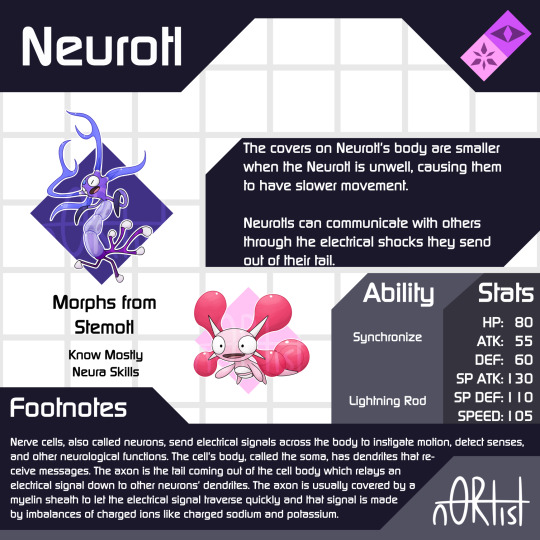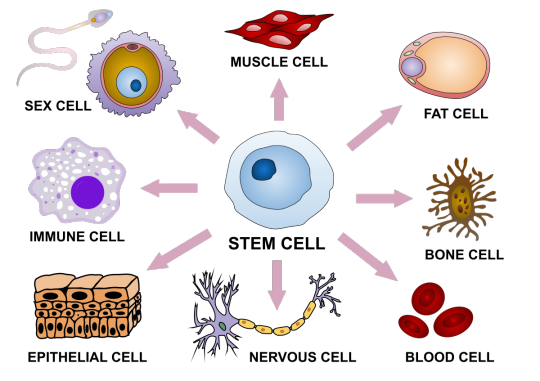#Stem Cell
Text


















Here’s the latest Stemae, featured in my previous video.
Stemotl (Chroma): While Stemotls are not native to this region, they have been popular in research worldwide for their regenerative abilities. Researchers predict there is a way to reverse Stemotl's morphing process; however the process is still being studied.
Neurotl (Chroma/Neura): The covers on Neurotl's body are smaller when the Neurotl is unwell, causing them to have slower movement. Neurotls can communicate with others through the electrical shocks they send out of their tail.
Myotl (Chroma/Forta): Fully relaxed Myotl arms can stretch out to be pretty long; however some parts are usually contracted. Myotls can understand the secret messages Neurotls communicate through the Neurotls' tails.
Dermotl (Chroma/Phasma): Dermotl's wings are grown from Dermotl's body and they have to be replenished as parts of the wing shed off over time. Dermotls sometimes rip-off their cloaks to protect younger Stemotls.
Osteotl (Chroma/Metalla): Osteotls can make a sturdy home for themselves by spitting out and forming a bone matrix which they can reabsorb if needed. Some reports claim seeing a Myotl throw an Osteotl at an enemy to deter them with Osteotl's spines.
Adipotl (Chroma/Toxa): The sticky covers on Adipotl allow them to stick to each other and various surfaces to block certain passageways. Adipotls can use their storage to generate heat in cold climates, welcoming Stemotls to huddle around them.
#education#health#biology#art#oc#science#logic & passion#stem#steam#Youtube#stem cell#nerve#muscle#skin#bone#fat#STEMA
223 notes
·
View notes
Text

Meet the unsung contributor to revolutionary breakthroughs in treating polio, cancer, HPV, and even COVID-19: Henrietta Lacks. Born in 1920 Roanoke, Virginia, Henrietta's mother Eliza died when she was only four, and she was ultimately raised by her maternal grandfather in Clover, Virginia. Henrietta worked as a tobacco farmer and attended a segregated school until the age of 14, when she gave birth to a son, Lawrence. A daughter, Elsie, was born three years later --to compound the family's difficulties, Elsie had cerebral palsy and epilepsy. Henrietta and her now-husband David Lacks moved to Turner Station (now Dundalk), Maryland where David had landed a job with a nearby steel plant. At the time Turner Station was one of the oldest African-American communities in Baltimore County and there was sufficient community support for the family to buy a house and produce three more children.
In 1951 at the age of 31, Henrietta died at Johns Hopkins Hospital of cervical cancer, mere months after the birth of the family's youngest son. But before her death --and without her or her family's consent-- during a biopsy two tumour cell samples were taken from Henrietta's cervix and sent to Johns Hopkins researchers. Hernietta's cells carried a unique trait: an ability to rapidly multiply, producing a new generation every 24 hours; a breakthrough that no other human cell had achieved. Prior to this discovery, only cells that had been transformed by viruses or genetic mutations carried such a characteristic. With the prospect of now being able to work with what amounted to the first-ever naturally-occurring immortal human cells, researchers created a patent on the HeLa cell line but hid the donor's true identity under a fake name: Helen Lane.
It is no exaggeration to state that in the 70 years since her death, Henrietta's cells have been bought, sold, packaged, and shipped by thousands of laboratories; with her cells being used as a baseline in as many as 74,000 different studies (including some Nobel Prize winners). Her cells have even been sent into space to study the effects of microgravity, and were instrumental in the Human Genome Project. While no actual law (or even a code of ethics) necessarily required doctors to ask permission before taking tissue from a terminal patient, there was a very clear Maryland state law on the books that forbade tissue removal from the dead without permission, throwing the situation into something of a legal grey area. However because Henrietta was poor, minimally educated, and Black, this standard was quietly (and easily) circumvented and she was never recognized for her monumental contributions to science and medicine ...and her family was never compensated. The family remained unaware of Henrietta's contribution until 1975, when the HeLa line's provenance finally became public. Henrietta had been buried in an unmarked grave in the family cemetery in Clover, Virginia but in 2010 a new headstone was donated and dedicated, acknowledging her phenomenal contribution. That same year the John Hopkins Institute for Clinical and Translational Research established a new Henrietta Lacks Memorial lecture series. A statue of Lacks was commissioned in 2022, to be erected in Lacks's birthplace of Roanoke, Virginia --pointedly replacing a previous statue of Confederate Gen. Robert E. Lee, which had been removed following nationwide protests over the murder of George Floyd.
Dive into The Immortal Life of Henrietta Lacks by Rebecca Skloot, originally published in 2011 and subsequently adapted into an HBO movie in 2017, starring Oprah Winfrey as Henrietta's daughter Deborah and Renee Elise Goldberry as Henrietta. (And yes, this book has been challenged and banned in more than one school district.)
#black lives matter#henrietta lacks#johns hopkins#cell biology#hela#stem cell#translational research#genomics#teachtruth#dothework
59 notes
·
View notes
Photo

Brainteasers
For all our amazing progress in science, there are still surprisingly unsolved mysteries. Take multiple sclerosis (MS), a nervous system disease affecting 2.5 million people worldwide. Despite studying it for over 200 years, we still don't fully understand why MS develops. Part of the reason is a lack of high-quality lab models for MS, which limits the discoveries scientists can make. Now, researchers have built a mini-brain organoid that could unlock new insights into the disease. By comparing organoids grown from people with and without MS, they pinpointed a key difference. Compared to healthy stem cells, those from MS patients (blue) lose the ability to become a variety of different cell types (red), instead becoming neurons (green) at a higher rate. This lost ability may explain why some people with MS can't repair the damage to their nervous system. Targeting this process could help us prevent and treat MS more effectively.
April 24th – 30th is Multiple Sclerosis Awareness Week 2023
Written by Henry Stennett
Biology Open cover image from work by Nicolas Daviaud and colleagues
Tisch Multiple Sclerosis Research Center of New York, New York, NY, USA
Image originally published with a Creative Commons Attribution 4.0 International (CC BY 4.0)
Published in Biology Open, March 2023
You can also follow BPoD on Instagram, Twitter and Facebook
#science#biomedicine#neuroscience#myelin#multiple sclerosis#multiple sclerosis awareness week#neurons#immunofluorescence#stem cell#organoid
12 notes
·
View notes
Text

This is a liquid Nitrogen dry shipper, used to transport cryopreserved products like stem cells and vaccines.
#interesting#interesting facts#nature is everything#nature is weird#nature#discover#thats interesting#thats insane#thats incredible#liquid nitrogen#what the shit#what the actual fuuuuuck#what the heck#what the flip#what the hell#what the fuck#stem#stem cells#stem cell#vaccine#cell#cells#science#woah#like woah#woahhhh#woah dude#woah :0#but woah#woah woah woah
2 notes
·
View notes
Text


Eevee is the stem cell of the Pokémon universe. Change my mind.
2 notes
·
View notes
Text

Cannabigerolic acid (CBGA): everything you need to know about the ‘stem cell’ of cannabinoids
Have you ever heard of CBGA, a sort of ‘mother cannabinoid’ that is revolutionising the medical cannabis industry?
During the ripening of the marijuana flowers, CBGA plays a key role in the development of the most popular cannabinoids. In this post we explain everything there is to know about this compound so you’re up to date with its huge future potential.
Cannabigerolic acid or CBGA is the acidic form of cannabigerol (CBG), one of the cannabinoids with the greatest potential for cannabis-based therapeutic treatments. This is just one of a growing list of new compounds that have the capacity to completely turn the marijuana industry upside down.
Read the article here, at Kannabia Seeds Blog
#cbga#cannabigerolic#cannabis#cannabigerolic acid#acid#cannabis news#cbd#marijuana#kannabia seeds#kannabia#seeds#medical cannabis#cannabinoids#stem cell
3 notes
·
View notes
Text
Frequency of Stem Cell Therapy

Stem cell therapy is a groundbreaking medical procedure that uses stem cells to treat a variety of diseases and injuries. Stem cells have the potential to develop into several types of cells, making them useful for tissue repair and regeneration. The frequency of stem cell therapy varies according to unique conditions, such as the specific illness, patient needs, and medical guidance.
Contrary to popular assumption, more frequent treatments do not always result in better outcomes. Each patient's treatment strategy should be tailored to their condition and reaction to therapy. The frequency of therapy is also influenced by the severity of the condition, the patient's age and overall health, and the type of stem cells used. Personalized treatment programs that take into account the patient's specific needs and goals are critical to achieving optimal results.
Follow-up appointments and assessments are scheduled on a regular basis to monitor progress and change the treatment plan as needed. The suggested frequency of stem cell therapy varies according to the illness being treated. For osteoarthritis, three to six therapy sessions spread out over several months are usually advised. Depending on the severity, sports injuries may necessitate one or many treatments over a period of weeks or months.
Autoimmune illnesses may involve continuing treatment to control symptoms and prevent disease development. However, it is crucial to note that these recommendations are not universally applicable and may differ depending on specific situations. The treating physician will establish the most appropriate treatment frequency depending on the patient's specific needs.
0 notes
Text
A Stem Cell is a Cell that doesn't have a purpose yet, it turns into something when the body needs a certain cell. There are certain parts of the body that can turnover cells very quickly, some would take longer and others wouldn't. What triggers stem cells is prolonged fasting for 72 hours or even longer. The Fat-burning Effect that Occurs in Fasting Really Helps to Fuel the Stem Cells. Certain parts of the Body that can Turnover New Cells:
• Hippocampus — It is a part of the brain that involves a relay switch with memory and stress responses.
• Beta Cells (Pancreas)
• Bone — The immune cells can be replaced.
• Colon Cells
PKA — A gene that needs to shut down for stem cells to spread and rebuild. Prolonged fasting could lower PKA.
— Dr. Eric Berg DC

0 notes
Text
A woman is cured of HIV, thanks to Stem Cell Therapy.
0 notes
Text
0 notes
Text
How Stem Cell Therapy Aids In The Recovery Of Myocardial Infarction?
The idea of introducing stem cells into the body for myocardial regeneration has recently received tremendous interest among medical researchers. The post-recovery period of the patients affected with myocardial infarction, commonly called “heart attack,” poses a lot of challenges. The lack of oxygen supply to the cardiac muscles is the primary cause of a heart attack and, at times, can be life-threatening. Myocardial infarction is a case of emergency requiring immediate medical attention from healthcare professionals.

Stem Cell Therapy for Myocardial Infarction (MI)
Although stem cell therapy is not a definitive cure for myocardial infarction, it can reduce the occurrence of such unfortunate instances in the future. Cell-based regenerative medicines aid in the restoration of cardiac function and, hence, are currently emerging as a promising treatment approach for MI patients.
Early reports and clinical trials on animal models demonstrate the therapeutic utilization of stem cells for cardiac tissue regeneration after myocardial infarction. Stem cells, particularly mesenchymal stem cells collected from human umbilical cord tissue, have vast potential to differentiate and form any cell type. This distinct property has captured the attention of medical communities, ushering hopes to millions of MI patients.
How Stem Cells Promote Cardiac Regeneration - The Mechanism
A chronically infarcted heart needs repair and the introduction of stem cells augment cardiac functions and retain the muscle properties to pump blood and oxygen to and from the heart. Moreover, stem cell treatment for myocardial infarction stimulates the paracrine action of the stem cells, which facilitates the neighboring cells in maintaining their replicative or regenerative potential and encourages the differentiation of cardiac stem cells. The growth of new blood vessels in heart muscles, known as angiogenesis in medical terms, also contributes to the recovery of heart function. Moreover, the stem cells stabilize the extracellular matrix and enhance the repair and restoration process of heart muscle cells.
Several preliminary studies have demonstrated that stem cell therapy for myocardial infarction is safe and effective, resulting in an improvement in myocardial perfusion. Interestingly, evidence suggests a remarkable transformation of undifferentiated stem cells into new cardiac muscle cells (cardiomyocytes) to enhance scar tissue formation and neovascularization. Other beneficial effects of stem cell therapy for post-stroke recovery are increased apoptosis (programmed cell death to eliminate damaged cells) and regulation of inflammatory response to reduce the impact on the heart post-stroke.
Modes of Stem Cell Delivery
Several routes or modes can be used to deliver stem cells to the injured site in the heart or myocardium. The method is determined by stem cell specialists from experienced and reliable stem cell therapy clinics based on the patient’s age, severity of the stroke, and overall health. The most preferred route is intravenous infusion, which is safe and non-invasive. Another process is the intracoronary infusion, where high concentrations of stem cells are injected into the central lumen of a balloon catheter, which facilitates quick delivery of cells into the myocardium. Apart from these two, a few other routes of delivery are there, but their applications are limited to a few research groups till now.
Conclusion
Stem cell therapy is a novel hope for myocardial infarction patients to get back to their normal lives. Stem cells revive the cardiac tissues in the infarct zone and enhance the functional capacity of the heart. For long-term survival and prevention of future events of heart attacks, stem-cell-based therapies have become realistic options for millions of individuals. Connect with the best stem cell therapy institute in Mexico, Life Altering Stem Cell Therapy Institute, to start your journey of healing your heart post-myocardial infarction.
1 note
·
View note
Text
Exploring the Possibilities of Stem Cell for Hair Treatment

The article “Exploring the Possibilities of Stem Cell for Hair Treatment” on Forhair.com provides an in-depth look at the innovative approach to using stem cell therapy for hair loss treatment. Here’s a brief review.
The article effectively explores the potential of stem cell therapy in treating hair loss, presenting it as a promising, albeit costly, alternative to traditional methods. It provides a comprehensive overview of the process, benefits, and considerations involved in stem cell hair treatment, making it a valuable read for anyone considering advanced options for hair restoration.
Read more about stem cell for hair treatment
0 notes
Text
What are the benefits of stem cell growth-promoting supplements?

Stem cell growth-promoting supplements are believed to offer several potential benefits, although it's essential to note that scientific research in this field is ongoing, and individual responses may vary. Some potential benefits includes here- https://www.facebook.com/CareforeGlobal
0 notes
Text

How Carries Out The Regenerative Medication Work?
Regenerative medication takes advantage of the body's all-natural capability to fix as well as switch out wrecked cells. It usually involves approaches like stalk tissue treatment, tissue engineering, and development element management. These strategies activate the physical body's personal regenerative procedures, marketing the repair of damaged or even impaired tissues and also body organs. This area secures commitment for handling a large variety of clinical health conditions and also traumas, potentially causing tissue regrowth and enhanced individual outcomes. https://nuutro.co.uk/
0 notes
Text
Regenerative medicine clinic
As a field, regenerative medication incorporates concepts of biology and also design to build therapies for diseases characterized by tissue deficiency, lost cells, or even damaged organs. The vast goal of regenerative medication is actually to developer, regenerate, or even replace cells utilizing natural growth as well as repair service systems, including stem tissues. Organoids, 3D body organ publishing, and tissue design are actually instances of biopowered modern technologies made use of in regenerative medication.
0 notes









